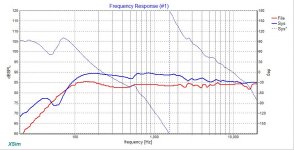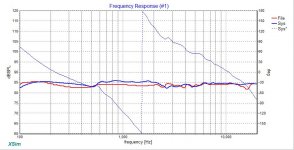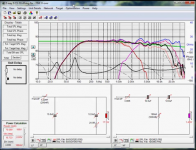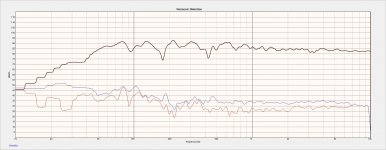There may be no meaningful difference in the FR between the Continuum and the LM-1 by the way. As I noted in a couple of places in the documentation, any differences between the LM-1 and the Continuum may in fact be an artifact that I like to use gated, 1m measurements instead of quasi-anechoic.
As for parts cost... it's not the only measure of quality. I suspect however that the overall costs are equal, or insignificantly close. The LM-1 uses more expensive coils, and recommends better crossover parts. Also, the XT25 tweeter is very highly though of. That it's less expensive than the Dayton is a ridiculous way to judge performance. The Peerless fiberglass woofer is not well known, but I consider it a great find.
One other thing, the LM-1 is not a commercial product, but a tool to share and educate. The point of the blog isn't to make LM-1 armies, but to encourage the beginners and share great sounding music. One thing I have seen happen again and again is that music lovers exposed to great speakers suddenly become interested in more and different types of music. That is the point. If some one wants to use a random set of double standards to compare the LM-1 to the Continuum that's fine. Others will build the LM-1 and get more involved in speaker building and music appreciation.
Best,
Erik
As for parts cost... it's not the only measure of quality. I suspect however that the overall costs are equal, or insignificantly close. The LM-1 uses more expensive coils, and recommends better crossover parts. Also, the XT25 tweeter is very highly though of. That it's less expensive than the Dayton is a ridiculous way to judge performance. The Peerless fiberglass woofer is not well known, but I consider it a great find.
One other thing, the LM-1 is not a commercial product, but a tool to share and educate. The point of the blog isn't to make LM-1 armies, but to encourage the beginners and share great sounding music. One thing I have seen happen again and again is that music lovers exposed to great speakers suddenly become interested in more and different types of music. That is the point. If some one wants to use a random set of double standards to compare the LM-1 to the Continuum that's fine. Others will build the LM-1 and get more involved in speaker building and music appreciation.
Best,
Erik
There may be no meaningful difference in the FR between the Continuum and the LM-1 by the way. As I noted in a couple of places in the documentation, any differences between the LM-1 and the Continuum may in fact be an artifact that I like to use gated, 1m measurements instead of quasi-anechoic.
I will pledge to disagree. Jeff Bagby designed the Continuum to achieve a natural midrange with a bass bump to simulate the LS3/5A. You seemed to designed the LM-1 to get high efficiency with a 700-3000 Hz boost. The 5 dB in your simulation is very unusual. Forget the measuring technique for a moment, compare your simulation to the curves post at this thread:
The crossover for a modest DIY bookshelf speaker project
I start the speaker design and thread. But credit goes to wintermute and Zuhl and others to make the crossover as successful as it is. It just happened that I also used the Dayton Audio RS28A-4 tweeter as in Continuum.
While I share you goal, but it is equally important to address the basic when designing a good speaker. By ignoring the BSC and cone breakup, you are missing some very important issues. How does the Paul Carmody design process that I linked to in Post #358 compare to yours? I will strongly encourage you to give it a try.One other thing, the LM-1 is not a commercial product, but a tool to share and educate. The point of the blog isn't to make LM-1 armies, but to encourage the beginners and share great sounding music.
Erik
Last edited:
I found some of the most basic consideration were missing. The LM-1 made no attempt to correct for the Baffer Step Compensation
Baffle step can be achieved with speaker placement (it's a bookshelf anyway). Most/common bookshelf crossover design requires that the speaker to be positioned almost 1 meter from wall, which is not always possible.
or the cone breakup. The 830991 woofer has the same 4-5 KHz cone breakup like other midbass plastic cone woofers (seen from spec sheet). When the crossover frequency is as high as in the LM-1, a RLC shunt is mandatory because the cone breakup effect is so audible.
In my book, 1k8 is not a high crossover point for a small midwoofer...
My ears are so sensitive to distortion, but how many designs have been made without addressing the woofer cone breakup? I think there are many. As long as people do not find it disturbing for their ears then it's okay.
And don't forget, the cure to any disease can be more dangerous than the disease itself. RLC filter is such.
LM-1 tried to achieve higher efficiency instead of smooth response. It is not the same as the LS3/5A or the Continuum.
I don't think the higher efficiency is a design goal. May be it is just a "side-effect". Basically nobody want to sacrifice efficiency for no compensation. In small bookshelf such as LS3/5A, you can trade efficiency with low frequency response, but such has limitation in the woofer itself.
I myself put "little" importance in FR flatness. I mean, if you have so many objectives to trade off (NLD is one of them, which is often absent in others) FR flatness can be something you want to sacrifice. The bump at crossover frequency, which is the area where both drivers work in the same phase, can give subjective positive effect to the ears, especially if the distortion is low or highly dominated by 2nd order distortion, which I predict the XT25 may provide.
NLD is a little too high a level of comparison
If you mean the NLD in the LM-1 is too high, I guess so myself but I don't know for sure because I'm not familiar with the drivers.
If it were the XT25TG, putting it in such crossover is a "suicide". And it's hard to believe if it's sibling used in the LM-1 has so big difference.
However, comparing it to the BBC LS3/5A and the Continuum is, should I say, presumptuous.
Well, then don't see it as an effort to predict which speaker is better, but see it as an effort to compare one speaker with the best possible speaker of similar size to see how much similarity between them.
Being presumptuous, may be it also apply to you. I mean, it is perfectly normal for beginners in speaker design to not realize that speaker design is not like building furniture, where a beginner may produce a furniture as good as those who have done it for years...
This is because you can learn the design tools in a day, and you can construct any crossover/speaker and it can produce sound...
It's different with amplifier design, where to reach the level of being able to produce design that can just create sound (not a "buzzz" or "boom") takes more time and knowledge...
But at higher level of achievement, amplifier design and speaker design has no difference! Most of the things that make a difference exist in speaker design.
It still seems like a shame to me that some people take price as the sole indication of quality. While it may be true in general, there are exceptions. The Vifa XT25 IS one of those exceptions i.m.h.o. Compare it to Scan Speak's pricy range of ring radiators and you'll notice that Vifa brings a whole lot for a very low price.
The heritage is clear in that tweeter, it isn't that different from it's $ 300,00+ sister drivers. Some even think it's better than what they made for their own line. I do miss the days that Scan Speak used the Vifa name for their experiments.... Even though those days are long gone, we still have some gem's left of that period.
The heritage is clear in that tweeter, it isn't that different from it's $ 300,00+ sister drivers. Some even think it's better than what they made for their own line. I do miss the days that Scan Speak used the Vifa name for their experiments.... Even though those days are long gone, we still have some gem's left of that period.
Keilau has no idea what he's talking about. That's fine except he's also wure he's right so I'm not even going to bother. I wish Dissi was around, he'd be able to make a great independent model.
+1 Wesayso, except I'm not even sure the SS model is different in any way. The specs are identical as far as I could tell. I'll use the SS in the commercial version so I can bump up the price by a grand. 😀 😀 😀
Best,
Erik
+1 Wesayso, except I'm not even sure the SS model is different in any way. The specs are identical as far as I could tell. I'll use the SS in the commercial version so I can bump up the price by a grand. 😀 😀 😀
Best,
Erik
So here's the direct comparison between the Continuum and the LM-1. Again, I note that the differences may be only due to measurement technique, except for the sensitivity which is due to the drivers, and bass extension.

But let's assume those differences are real. If you adjust R1 as discussed in the blog, and also change the levels in the graph so the two speakers line up, you get this:

Except in the bass extension, with the change in R1 there is no difference in the two speakers. Having actually listened to the LM-1 (which is plenty bright), I'm pretty sure the differences in the first chart are not real (unless Bagby and others are deaf above 2kHz), but if they were the model says we would get to a nearly identical mid bass to treble performance by switching a resistor. Any claims of the LM-1 being less smooth or in any way deficient in the frequency domain are meaningless horse hockey.
So, here is the double standard. Kileau or whatever, wants to complain that I did a technical comparison without hearing the Continuum (which I make clear in my blog) but wants to compare our two speakers without hearing them.
Based on these two FR plots alone, I'd say there's no meaningful difference and only a side by side comparison would be able to tell, and it would be purely a matter of personal taste which was better. Anyone who claims otherwise has been reading too many reviews.
Best,
Erik
But let's assume those differences are real. If you adjust R1 as discussed in the blog, and also change the levels in the graph so the two speakers line up, you get this:
Except in the bass extension, with the change in R1 there is no difference in the two speakers. Having actually listened to the LM-1 (which is plenty bright), I'm pretty sure the differences in the first chart are not real (unless Bagby and others are deaf above 2kHz), but if they were the model says we would get to a nearly identical mid bass to treble performance by switching a resistor. Any claims of the LM-1 being less smooth or in any way deficient in the frequency domain are meaningless horse hockey.
So, here is the double standard. Kileau or whatever, wants to complain that I did a technical comparison without hearing the Continuum (which I make clear in my blog) but wants to compare our two speakers without hearing them.
Based on these two FR plots alone, I'd say there's no meaningful difference and only a side by side comparison would be able to tell, and it would be purely a matter of personal taste which was better. Anyone who claims otherwise has been reading too many reviews.
Best,
Erik
Attachments
Last edited:
It still seems like a shame to me that some people take price as the sole indication of quality. While it may be true in general, there are exceptions. The Vifa XT25 IS one of those exceptions i.m.h.o. Compare it to Scan Speak's pricy range of ring radiators and you'll notice that Vifa brings a whole lot for a very low price.
The heritage is clear in that tweeter, it isn't that different from it's $ 300,00+ sister drivers. Some even think it's better than what they made for their own line. I do miss the days that Scan Speak used the Vifa name for their experiments.... Even though those days are long gone, we still have some gem's left of that period.
You're favorite Vifa tweeter ? Don't like the 19 more ?
I don't know if mentioned already but Jim Rogers JR149 is a memorable such effort from that era. I.e. to try build something better in similar size to LS3/5A based on B110 & T27. For better looking it rather succeeded, for better overall performance not sure 🙂
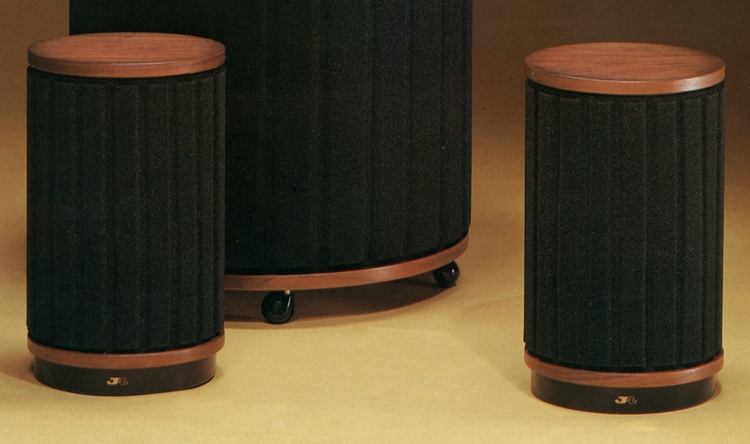

I don't know if mentioned already but Jim Rogers JR149 is a memorable such effort from that era. I.e. to try build something better in similar size to LS3/5A based on B110 & T27. For better looking it rather succeeded, for better overall performance not sure 🙂

Those actually look really nice! Now I bet I could combine them with a Roomba charging station and make a fortune.
Best,
Erik
Keilau has no idea what he's talking about. That's fine except he's also wure he's right so I'm not even going to bother. I wish Dissi was around, he'd be able to make a great independent model.
Best,
Erik
I am in a learning journey myself. My first crossover attempt ended up in a very similar situation as the LM-1 is now, namely, with a midband bump from 800 to 3K Hz. I found it unnatural and posted at this forum for help in August 2015.
http://www.diyaudio.com/forums/multi-way/278728-crossover-modest-diy-bookshelf-speaker-project.html
From many years of building UK magazine speaker design, my crossover took into account of the driver roll-off to achieve a 3rd order symmetrical. The Dayton Audio RS28A-4 was chosen to allow a lower crossover point because of the 6.5" woofer. I received many suggestions on the importance of accounting for BSC and cone breakup. Some actually made mod to my schematic which I found to vastly improve the naturalness and staging of the sound. I use a subwoofer. I designed for good bass transient instead of a mid bass bump.
In the recent post #366, you indicated that you can get a more leveled response by adjusting R1, but losing 5 dB of efficiency. Which one sound more natural to you? I know that the sound of a speaker is a personal preference. If you like the design with a tiled response curve and a midband bump better, it is fine. But try the BSC and RLC null circuit sometime and see how you like it.
From my other thread:
I hope that the wonderful work on the crossover by many posters, particularly jReave and Wintermute, will encourage DIYers to look at the drivers used in this project. I picked them to be the good value drivers for under $250 total.
The crossover should be applicable to both vented or closed box designs.
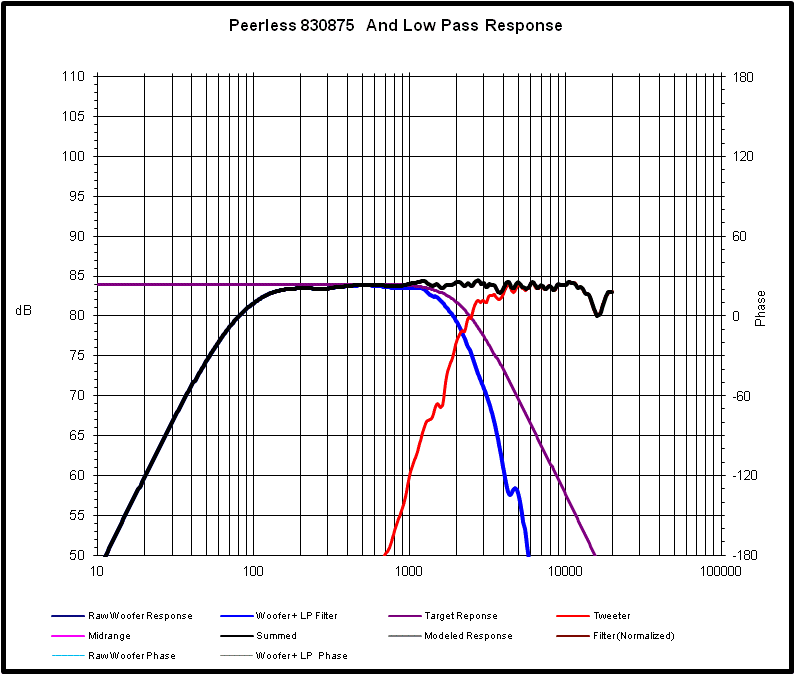
Last edited:
you can get a more leveled response by adjusting R1, but losing 5 dB of efficiency. Which one sound more natural to you? I know that the sound of a speaker is a personal preference. If you like the design with a tiled response curve and a midband bump better, it is fine. But try the BSC and RLC null circuit sometime and see how you like it.
From my other thread:
Keilau, I agree with you on the effect of leveled response on the naturalness of the sound. But remember, there are other considerations, which may be more important than that. Have all these considerations been considered?
Let's look at your speaker chart you just posted. What does it say regarding to the sound? I think none (not even naturalness!). Many people like to display chart just to show how flat it is. But what is the point? Give me resources files and I can create the flattest FR with several probably strange looking crossovers, because it is a simple Math. Every simulators have that most useful feature, which is called "optimizer". The optimizer will find the filter structure and the values of each component to meet a given "response goal".
There are fuzzy things that experienced designers learned during their journeys. But technically and objectively, imo, at least 3 simple outputs should be shown or addressed. They are (1) phase response (2) transient response (3) harmonic distortions...
From the three above, only distortions that was not displayed/addressed by Eric. Now try to check/show the other two outputs of your speaker (phase and impulse), then you will see (if you know how to understand the pictures) what you have compromised.
If you like the design with a tiled response curve
Tiled response curve is a "strategy" that I found by auto-didactic. I know exactly why I use this strategy and I think you can't find the "why" on the internet. These are things that you learn only from experience.
Google for "FINE X Over demo" and you will notice that in the demo of the software Peter Larsen uses a tiled response goal.
Attachments
There are fuzzy things that experienced designers learned during their journeys. But technically and objectively, imo, at least 3 simple outputs should be shown or addressed. They are (1) phase response (2) transient response (3) harmonic distortions...
From the three above, only distortions that was not displayed/addressed by Eric. Now try to check/show the other two outputs of your speaker (phase and impulse), then you will see (if you know how to understand the pictures) what you have compromised.
Jay, it will not be right for me to hijack this thread to discuss my own bookshelf venture. The one chart was shown as illustration. Please, go to the original thread I linked which is 7 pages long and has the contribution from many of the respected members on this forum. Check it out if you want to comment and, please, do it over there. The final crossover design is very different from what I started with in post #1, and sound much better.
The linear phase and rapid transient are trade marks of the British school of speaker design which often require more complex crossover. The LM-1 did not address these issues. You can find many good example and excellent design at Troels Gravesen's website such as this:
Peerless HDS 134 +
See how his crossover differs from the LM-1 for a somewhat similar bookshelf design. (BTW, Troels Gravesen is in Danmark, not UK) On the other hand, distortion is more a driver function. I look at the Xmax (linear excursion) as the first step.
Jay, you have been around for a long time. Until you share some of your speaker project on this forum, I cannot take you seriously. Anyone can Google for "FINE X Over demo", but there are good as well as misinformation all over.
Last edited:
The XT25BG is kind of a monster, in a good way. I can't measure the LM-1 right now, but my choices were made on the work I had done on it's sibling, the LM-1 Center channel.
For the LM-1C I did measure distortion at 1 watt. The 1C crossover slopes are a little steeper, and crossover point just a hair lower but please take a look at the 2nd and 3rd order HD plots (OmniMic's DB scales here are questionable). Above 800 Hz 2nd and 3rd order distortion measurements were under 0.35%
There's no 5 kHz breakup filter here either. In the LM-1 that breakup mode was only about 5dB above the rest of the woofer level, and 22 dB down after filtering. There's absolutely no evidence of it in the FR or distortion plots, and no evidence at all of the tweeter being crossed over too low. As was mentioned, adding a notch filter would destroy a heaven-sent phase matching that I am not about to mess with. Having a very simple crossover was a design goal, and I've no reason to alter that. A second order symmetrical crossover plus Zobel and a tweeter resistor is pretty damn simple in my opinion.
By measuring the drivers in place I avoid the issue of doing separate BSC calculations. As is usual for me, I took far field measurements with the drivers in place and then spliced in the near field woofer measurements to smooth out the woofer plot. This data then fed into XSim before I began the crossover design. Any baffle step issues were baked into my woofer measurements from the start. The truth of this is not in the schematic but in the FR plot. If I had messed that up you'd see it. What BSC was needed is essentially achieved by L2 and it's DCR.
Neither the center channel nor the LM-1 show any audible issues claimed by arm-chair experts, but I'm still tweaking the tweeter level on the LM-1. My original recommendation was too high a tweeter level.
So, 'nough said.

For the LM-1C I did measure distortion at 1 watt. The 1C crossover slopes are a little steeper, and crossover point just a hair lower but please take a look at the 2nd and 3rd order HD plots (OmniMic's DB scales here are questionable). Above 800 Hz 2nd and 3rd order distortion measurements were under 0.35%
There's no 5 kHz breakup filter here either. In the LM-1 that breakup mode was only about 5dB above the rest of the woofer level, and 22 dB down after filtering. There's absolutely no evidence of it in the FR or distortion plots, and no evidence at all of the tweeter being crossed over too low. As was mentioned, adding a notch filter would destroy a heaven-sent phase matching that I am not about to mess with. Having a very simple crossover was a design goal, and I've no reason to alter that. A second order symmetrical crossover plus Zobel and a tweeter resistor is pretty damn simple in my opinion.
By measuring the drivers in place I avoid the issue of doing separate BSC calculations. As is usual for me, I took far field measurements with the drivers in place and then spliced in the near field woofer measurements to smooth out the woofer plot. This data then fed into XSim before I began the crossover design. Any baffle step issues were baked into my woofer measurements from the start. The truth of this is not in the schematic but in the FR plot. If I had messed that up you'd see it. What BSC was needed is essentially achieved by L2 and it's DCR.
Neither the center channel nor the LM-1 show any audible issues claimed by arm-chair experts, but I'm still tweaking the tweeter level on the LM-1. My original recommendation was too high a tweeter level.
So, 'nough said.
Attachments
Last edited:
Jay, it will not be right for me to hijack this thread to discuss my own bookshelf venture.
Okay. My comment about this and similar thread is: when the experts have chimed in, the problem/question should already been answered in the first one or two pages... (even tho I have observed that some beginners tend to underestimate the answers, may be because they don't know which ones are the experts, or they cannot imagine the depth of the experts' knowledge).
I believe that to understand the answers to the original questions, one must understand the several issues in speaker design because they are related. We will not understand the LS3/5A if we don't understand about why sensitivity is so low there or why the transfer function is like what it is. In simple words, your situation (and also Eric's) is related imho.
The one chart was shown as illustration.
I know (And I have criticized the use of it for illustration).
Check it out if you want to comment and, please, do it over there. The final crossover design is very different from what I started with in post #1, and sound much better.
I think I have seen it (may be I have posted there, I'm not sure).
The linear phase and rapid transient are trade marks of the British school of speaker design which often require more complex crossover.
I tend to think the opposite. It is easier to achieve both with less complex crossover (first and second order).
The LM-1 did not address these issues.
I think Eric has shown phase and transient response charts. You rarely seen people show this kind of information around here, haven't you?
You can find many good example and excellent design at Troels Gravesen's website such as this:
Peerless HDS 134 +
Honestly I will not call that one (HDS+XT25) an excellent design.
See how his crossover differs from the LM-1 for a somewhat similar bookshelf design.
Yes, the crossover is above 3kHz, while Eric's is below 2kHz. With similar rate of roll-off, the break-up at roll-off is attenuated significantly in LM-1.
But the woofers are different. And it is important to see the distortion, because it doesn't equal to the amplitude of the response peak.
On the other hand, distortion is more a driver function.
Everything is a driver function. We can choose where we cross the drivers based on distortion information. It serves as the "base" distortion. What we do in the design may create higher level of distortion.
Jay, you have been around for a long time. Until you share some of your speaker project on this forum, I cannot take you seriously.
I'm fine with that. I assume that it is 100% readers interest, not mine. 😉
Anyone can Google for "FINE X Over demo", but there are good as well as misinformation all over.
I don't understand your point.
My point was to show that the technique was popular not only around amateur builders like me but also around experts like Peter Larsen. But I follow the technique not because I read/hear about it, but because I know exactly what it does (adds/subtracts) to sound.
I'm interested to know what misinformation is in there?
To compare the quality of two speaker crossovers or the experience of the designer's based on the number of parts in the crossover is the most ridiculous thing I've seen since Amadeus where the Emperor Joseph II (played by Jeffrey Jones) tells Mozart "...there are simply too many notes, that's all. Just cut a few and it will be perfect" or the value of a painting based on it's size.
Hahahhahaha. 😀 😀 😀
"Hi, I'd like a 2-way speaker, oh, and Super Size the crossover please, I have guests coming over and I want to show them lots of parts. Put in some extras of those black round things in too."
Best,
Erik
Hahahhahaha. 😀 😀 😀
"Hi, I'd like a 2-way speaker, oh, and Super Size the crossover please, I have guests coming over and I want to show them lots of parts. Put in some extras of those black round things in too."
Best,
Erik
Last edited:
So, I've never heard the BBC monitors or Jeff Bagby's continuum, but if you are looking for a small 2-way speaker with glass smooth response with parts cost around $300 ($470 with cabinets) I suggest my own LM-1 design.
Just curious- there's a lot of on-axis data presented; did you do comparable measurements off-axis?
You're favorite Vifa tweeter ? Don't like the 19 more ?
I'm using the cheapest XT25 SC90 (neo magnet) in my car with my own design faceplate:

Here it is in the Car:

Don't you just love 3D printing? 🙂
(P.S. the blue you see in the lower right corner is a piece of Lego to balance the tweeter 😉)
Last edited:
Um, they look a little obscene. Like your car door is feeling the cold and your tweeter is poking out.
Just curious- there's a lot of on-axis data presented; did you do comparable measurements off-axis?
Sorry Sy, no such data right now.
Um, they look a little obscene. Like your car door is feeling the cold and your tweeter is poking out.
They do have a very seductive sound 🙂
- Home
- Loudspeakers
- Multi-Way
- Can one build a better (non) LS3/5A speaker based on T27s & B110s?
